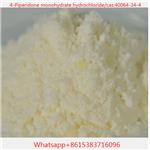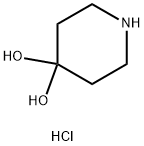4,4-Piperidinediol hydrochloride: properties, applications and safety
Oct 12,2023
General Description
4,4-Piperidinediol hydrochloride is a synthetic organic compound used as an intermediate in the production of various drugs and organic compounds. It is soluble in water, stable under normal conditions, and is produced by reacting piperazine with diethyl carbonate in the presence of hydrogen chloride gas. However, 4,4-Piperidinediol hydrochloride is also classified as a Category 2 skin and eye irritant and falls under Category 3 for specific target organ toxicity from single exposure. To ensure safe handling and use, proper protective equipment, ventilation, and hygiene practices are recommended.

Figure 1. 4,4-Piperidinediol hydrochloride
Properties
4,4-Piperidinediol hydrochloride is a synthetic organic compound with a molecular formula of C5H12ClNO2 and a molecular weight of 153.61 g/mol. It is a white crystalline solid with a melting point range of 185-189°C and is soluble in water. 4,4-Piperidinediol hydrochloride is produced by reacting piperazine with diethyl carbonate in the presence of hydrogen chloride gas to yield piperazine diol monohydrochloride, which is then crystallized to produce the desired product. The overall yield of this reaction is relatively high, generally around 80%. The stability of 4,4-piperidinediol hydrochloride depends on temperature and humidity, and it is hygroscopic. Under normal conditions, it can be stored in a cool, dark, and dry place for several months without significant degradation. However, exposed to light, moisture, or elevated temperatures for long periods, it may decompose or degrade, decreasing its purity and potency. For best results, it should be stored in a tightly sealed container and protected from light and moisture. 4,4-Piperidinediol hydrochloride is a key intermediate for the production of piperazine-containing drugs such as fentanyl analogs. It is used in the production of various drugs such as piperazine-based antipyretic analgesics and tranquilizers. It can also be used as an intermediate for dyes and other organic compounds. 1
Applications
4,4-Piperidinediol hydrochloride is a useful research chemical that has a variety of applications in organic synthesis and pharmaceuticals. It is also known as 4-piperidone hydrochloride monohydrate and is a commonly used organic raw material for the preparation of several organic intermediates such as 3-(dimethylamino)-N-methylsulfonyl-4-piperidone, haloperidol, and its derivatives. In the pharmaceutical industry, 4,4-Piperidinediol hydrochloride is an important intermediate for the synthesis of active compounds. It can be used as a precursor for the synthesis of P-gp inhibitors, which are compounds that modulate the activity of P-glycoprotein and can increase drug absorption. Additionally, 4,4-Piperidinediol hydrochloride can be used in the development of drugs for the treatment of various diseases including cancer, bacterial infections and neurological disorders. In conclusion, 4,4-Piperidinediol hydrochloride is a versatile and valuable chemical in organic synthesis and pharmaceuticals. Its ability to serve as a useful intermediate for the synthesis of a variety of biologically active compounds makes it an essential tool in drug discovery and development research and holds great potential for the treatment of various diseases. 2
Safety
4,4-Piperidinediol hydrochloride is a chemical compound with various safety considerations. It has been classified as a Category 2 skin irritant, meaning it can cause irritation upon contact. Additionally, it is categorized as a Category 2 eye irritant, indicating that it can cause serious eye irritation if it comes into contact with the eyes. Furthermore, it falls under Category 3 for specific target organ toxicity from single exposure, suggesting that it may cause harm to a specific organ if exposed to it. To ensure safe handling and use of this compound, several precautionary statements have been provided. These include wearing protective gloves, clothing, eye protection, face protection, and hearing protection. Adequate ventilation and avoiding inhalation of dust, fumes, gas, mist, vapors, or spray are also recommended. Proper hygiene practices such as washing thoroughly after handling and removing contaminated clothing before reuse are advised. Overall, the safety of 4,4-Piperidinediol hydrochloride lies in following the recommended handling and storage procedures, as well as promptly addressing any exposures or accidents that may occur. 3
Reference
1. 4,4-Piperidinediol, hydrochloride (1:1). CAS Common Chemistry, CAS: 40064-34-4.
2. Aschwanden P, Stephenson, CRJ, Carreira EM. Highly Enantioselective Access to Primary Propargyl Amines: 4-Piperidinone as a Convenient Protecting Group. Organic Letters, 2006, 8(11): P2437-2440
3. 4,4-Piperidinediol, hydrochloride (1:1) Safety Data Sheets. Echemi, 2019.
- Related articles
- Related Qustion
- 4,4-Piperidinediol hydrochloride: synthesis and applications in organic synthesis Dec 20, 2023
The synthesis of 4,4-Piperidinediol hydrochloride involves C-H and C-C bond functionalizations. It serves as a building block for bis-bispidine tetraazamacrocycles and pharmaceutical compounds.
- Intermediate role of 4,4-piperidinediol hydrochloride in organic synthesis Dec 23, 2019
4-piperidone hydrochloride, monohydrate, also known as azinanone hydrochloride, is a derivative of piperidine used as an intermediate in manufacturing pharmaceutical drugs and chemicals [1].
4-Chloro-2,6-diaminopyrimidine is a white crystalline solid with potential environmental applications and associated safety risks.....
Oct 12,2023APIPotassium benzoate (PB) is a food preservative that inhibit the growth of mold, yeast, and some bacteria. It carries a certain risk of cancer.....
Oct 12,2023Organic Chemistry4,4-Piperidinediol hydrochloride
40064-34-4You may like
4,4-Piperidinediol hydrochloride manufacturers
- 4-Piperidone hydrochloride monohydrate
-

- $10.00 / 1kg
- 2024-05-30
- CAS:40064-34-4
- Min. Order: 0.1kg
- Purity: 99%
- Supply Ability: 20ton
- 4,4-Piperidinediol hydrochloride
-

- $30.00 / 1KG
- 2024-01-04
- CAS:40064-34-4
- Min. Order: 1KG
- Purity: 99.9%
- Supply Ability: 20 Tons






